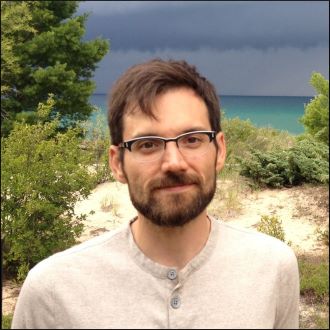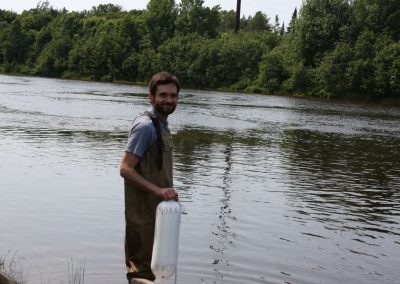Eric Anderson
Past Postdoctoral Research Fellow
In the News:
- Five NOAA Research scientists to receive Presidential awards for early career achievement, NOAA Research News, 7/15/2019
- ‘Crucial’ piece of Line 5 spill response offline due to federal shutdown, MLive, 1/16/2019
- Around the Circle This Week: November 30, 2018, Lake Superior Magazine, 11/30/2018
- Great Lakes Meteotsunami Experts Hone in on Big Wave Forecasts, Environmental Monitor, 7/2/2018
- GLERL Ocean(lake)ographer Eric Anderson on watching the Straits of Mackinac, NOAA GLERL Blog, 5/22/2018
- Tsunami Threat for the Great Lakes?, Great Lakes Now, 6/21/2017
- NOAA research to benefit Huron to Erie Corridor, The Voice, 8/30/2013
Photo Gallery
Eric Anderson, a physical scientist at NOAA’s Great Lakes Environmental Research Laboratory, is a leader in developing innovative tools to predict the physical nature of Great Lakes waters.
Traveling along channel. Professor Wu, along with Dr. Eric Anderson from GLERL, deployed sensors to study river dynamics/characteristics. As with the majority of GLERL’s projects, this is a collaborative effort. Through the Cooperative Institute for Limnology and Ecosystems Research (CILER), now the Cooperative Institute of Great Lakes Research (CIGLR), this work is supported by NOAA National Marine and Fishery Service and funded by EPA Great Lakes Restoration Initiative. The University of Wisconsin is one of ten CIGLR Consortium partners. Photo Credit: NOAA GLERL.
Eric Anderson CILER. Professor Wu, along with Dr. Eric Anderson from GLERL, deployed sensors to study river dynamics/characteristics. As with the majority of GLERL’s projects, this is a collaborative effort. Through the Cooperative Institute for Limnology and Ecosystems Research (CILER), now the Cooperative Institute of Great Lakes Research (CIGLR), this work is supported by NOAA National Marine and Fishery Service and funded by EPA Great Lakes Restoration Initiative. The University of Wisconsin is one of ten CIGLR Consortium partners. Photo Credit: NOAA GLERL.
Profile:
Dr. Eric J. Anderson began working with CIGLR researchers in 2007 as a postdoctoral research associate hosted by NOAA GLERL and has since served as an assistant research scientist at CIGLR before returning full-time to GLERL as a physical scientist and oceanographer. Dr. Anderson specializes in the modeling of the Great Lakes’ hydrodynamics, or the moments of large bodies of water imparted by meteorological activity. His work enables Great Lakes researchers to predict the movement of spills or harmful algal blooms, to inform warning systems of storm surges, and to better understand the mechanical forces shaping these aquatic environments.
Education:
- Ph.D. in Mechanical & Aerospace Engineering, Case Western Reserve University (2007)
- B.S. in Mechanical Engineering, Case Western Reserve University (2003)
Research Interest/Area of Expertise:
- Hydrodynamic Circulation Models
- Great Lakes Hydrodynamics, Currents, Temperatures and Water Levels
- Great Lakes Meteorology
- Great Lakes Forecasting
Recent Publications:
Gronewold, A.D., E.J. Anderson and J.P. Smith. 2019. Evaluating Operational Hydrodynamic Models for Real‐time Simulation of Evaporation from Large Lakes. Geophysical Research Letters. (DOI:10.1029/2019GL082289) [Altmetric Score]
Linares, A., C.H. Wu, A. Bechle, E.J. Anderson and D.A. Kristovich. 2019. Unexpected rip currents induced by a meteotsunami. Scientific Reports. (DOI:10.1038/s41598-019-38716-2) [Altmetric Score]
Rowe, M.D., E.J. Anderson, D. Beletsky, C.A. Stow, S.D. Moegling, J.D. Chaffin, J.C. May, P.D. Collingsworth, A. Jabbari and J.D. Ackerman. 2019. Coastal Upwelling Influences Hypoxia Spatial Patterns and Nearshore Dynamics in Lake Erie. Journal of Geophysical Research: Oceans. (DOI:10.1029/2019JC015192). [Altmetric Score]
Recent Presentations:
Anderson, E.J., P. Chu, G.A. Lang, A. Fujisaki-Manome, J.A. Kessler, J.G.W. Kelley, Y. Chen and A. Zhang. 2018. NOAA’s Next-Generation Lake Superior Operational Forecast System (LSOFS). State of Lake Superior Conference, Houghton, Michigan, October 12, 2018. International Association of Great Lakes Research.
Fujisaki-Manome, A., E.J. Anderson, J.A. Kessler, G.A. Lang, J. Wang, P. Chu and A.D. Gronewold. 2018. Impacts of Sensible Heat from Precipitation on Ice Cover in Large Lakes (poster). AGU Fall Meeting, Washington, D.C., Dec. 10-14, 2018.
Gronewold, A.D., L. Mason, C. Xiao and E.J. Anderson. Customizing the National Water Model to meet Regional Needs for Water Prediction. AGU Fall Meeting, Washington, D.C., Dec. 10-14, 2018.





